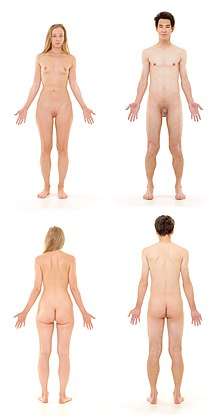Human physical appearance
Human physical appearance is the outward phenotype or look of human beings.

| Human appearance |
|---|
| Series on Human appearance |
|
| High level topics |
| Related topics |
Higher category: Human, Phenotype |
There are infinite variations in human phenotypes, though society reduces the variability to distinct categories. Physical appearance of humans, in particular those attributes which are regarded as important for physical attractiveness, are believed by anthropologists to significantly affect the development of personality and social relations. Humans are acutely sensitive to their physical appearance.[1] Some differences in human appearance are genetic, others are the result of age, lifestyle or disease, and many are the result of personal adornment.
Some people have linked some differences, with ethnicity, such as skeletal shape, prognathism or elongated stride. Different cultures place different degrees of emphasis on physical appearance and its importance to social status and other phenomena.
Factors affecting physical appearance
Various factors are considered relevant in relation to the physical appearance of humans.
Physiological differences
Humans are distributed across the globe with the exception of Antarctica, and form a variable species. In adults, average weight varies from around 88 pounds for the smallest and most lightly built tropical people to around 176 pounds for the heavier northern peoples.[2] Size also varies between the sexes, the sexual dimorphism in humans being more pronounced than that of chimpanzees, but less than the dimorphism found in gorillas.[3] The colouration of skin, hair and eyes also varies considerably, with darker pigmentation dominating in tropical climates and lighter in polar regions.
- Genetic, ethnic affiliation, geographical ancestry.
- Height, body weight, skin tone, body hair, sexual organs, moles, birthmarks, freckles, hair color, hair texture, eye color, eye shape (see epicanthic fold and eyelid variations), nose shape (see nasal bridge), ears shape (see earlobes), body shape
- Body deformations, mutilations and other variations such as amputations, scars, burns and wounds.
Short-term physiological changes
- Blushing, crying, fainting, hiccup, yawning, laughing, stuttering, sexual arousal, sweating, shivering, nose bleeding, skin color changes due to sunshine or frost.
Clothing, personal effects, and intentional body modifications
- clothing, including headgear and footwear; some clothes alter or mold the shape of the body (e.g. corset, support pantyhose, bra). As for footwear, high heels make a person look taller.
- style and colour of haircut (see also mohawk, dreadlocks, braids, ponytail, wig, hairpin, facial hair, beard and moustache)
- cosmetics, stage makeup, body paintings, permanent makeup
- body modifications, such as body piercings, tattoos, scarification, subdermal implants
- plastic surgery
- decorative objects (jewelry) such as a necklaces, bracelets, rings, earrings
- medical or body shape altering devices (e.g., tooth braces, bandages, casts, hearing aids, cervical collar, crutches, contact lenses of different colours, glasses, gold teeth). For example, the same person's appearance can be quite different, depending on whether they use any of the aforementioned modifications.
- exercises, for example, bodybuilding
Other functional objects, temporarily attached to the body
- Capes
- Goggles
- Hair ornaments
- Hats and caps
- Headdresses
- Headphones/Handsfree phone headset
- Jewelry
- Masks
- Prosthetic limbs
- Prosthetic genitals
- Sunglasses
- Watch
See also
| Wikimedia Commons has media related to Appearance. |
References
- Anderson-Fye, EP (2012). Cash, Thomas F. (ed.). "Anthropological Perspectives on Physical Appearance and Body Image" (PDF). Body Image and Its Disorder in Anthropology. 1. Academic Press: 19. doi:10.1016/B978-0-12-384925-0.00003-1. Retrieved August 9, 2018.
[Cases] of immigration have repeatedly shown that if a person who is obese believes that his or her body is beyond individual control but is placed into a medical system that assumes individual rational actors in its treatments, adherence is likely to be low and those treatments are ineffective...[Young] ethnic Fijian women associated the thin body ideal with a particular lifestyle that they found desirable
Cite journal requires|journal=(help) - "Anthropometric Reference Data for Children and Adults: United States, 2003–2006" (PDF). Retrieved 9 March 2014.
- Shea, Brian T. (1985). "The ontogeny of sexual dimorphism in the African apes". American Journal of Primatology. 8 (2): 183–188. doi:10.1002/ajp.1350080208.